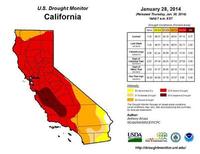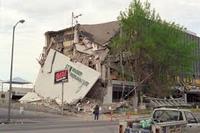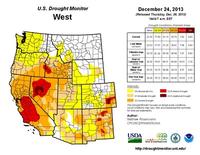-
Floods caused lead poisoning in U.K. cattle
Massive floods in England and Wales have forced thousands to evacuate their homes and destroyed railways and roads. Scientists say the U.K. floods of recent years carry yet another danger with them: lead poisoning. Silage cut from fields soon after they were inundated in the 2012 floods and then fed to cattle raised the lead levels in the animals, killing some of them. Blood samples taken from cattle showed that all of them had lead levels beyond the safe limit for human consumption. An autopsy carried out on one of the casualty animals found lead concentrations 79 times the safe level in its kidney. The contaminated material is thought to originate from historical metal mining in the area. Scientists say a number of river catchments throughout England and Wales face a similar risk.
-
-
Natural gas leaks a significant source of green-house gas methane

Methane, a key greenhouse gas, has more than doubled in volume in Earth’s atmosphere since 1750. Its increase is believed to be a leading contributor to climate change. Where is the methane coming from, however? Research by atmospheric chemist Paul Wennberg of the California Institute of Technology (Caltech) suggests that losses of natural gas – regarded as the “cleanest” fossil fuel — into the atmosphere may be a larger source than previously recognized.
-
-
33 A.D. Old Jerusalem earthquake helps determine age of Shroud of Turin

The Shroud of Turin has been at the center of scientific controversy and questions ever since Secondo Pia took the first photograph of it in 1898: whether it is Jesus’s purported burial cloth, how old it might be, and how the image was created. Scientists who conducted radiocarbon dating of the cloth in 1988 determined that the shroud was only 728 years old at the time, and thus that it could not have been in existence during Jesus’s life. Other scientists have since suggested that the shroud is much older, and thus that it could have been produced during Jesus’s time, and that the dating process was incorrect because of neutron radiation — a process which is the result of nuclear fusion or nuclear fission during which free neutrons are released from atoms — and its interaction with the nuclei of other atoms to form new carbon isotopes. No plausible physical reason, however, had been proposed to explain the origin of this neutron radiation – until now: Italian scientists say the source of the neutron emission is a historical earthquake in 33 A.D. in Old Jerusalem, which measured 8.2 on the Richter scale.
-
-
U.K. facing flood crisis, as prime minister warns victims they are in for “long haul”
David Cameron warns flooding victims that they are in for a “long haul,” as the weather service says the weather will get worse this week, leaving thousands more homes at risk. There is a growing anger at the government by residents who complain that in addition to lack of preparation and response – thus, there were many complaints that sandbags intended for the worst-hit areas being “hijacked” and unavailable to stem the rising water – government agencies have not provided enough security after resident were ordered to evacuate, leading to looting of vacant homes. Officials have predicted that thousands more homes will be flooded over the coming days and said restoring the country’s battered rail network could take months.
-
-
More than 60 percent of California suffers drought conditions, with no relief in sight

The entire west coast of the United States is changing color as the deepest drought in more than a century unfolds. According to the U.S. Department of Agriculture and NOAA, dry conditions have become extreme across more than 62 percent of California’s land area — and there is little relief in sight. “Up and down California, from Oregon to Mexico, it’s dry as a bone,” say a NAA scientist. “To make matters worse, the snowpack in the water-storing Sierras is less than 20 percent of normal for this time of the year.”
-
-
Coastal areas must adapt to sea-level rise and storm surges or suffer massive damage
A new study presents, for the first time, comprehensive global simulation results on future flood damages to buildings and infrastructure in coastal flood plains. Drastic increases in these damages are expected due to both rising sea levels and population and economic growth in the coastal zone. Asia and Africa may be particularly hard hit because of their rapidly growing coastal mega-cities, such as Shanghai, Manila, and Lagos.
-
-
Quake-vulnerable concrete buildings in Los Angeles area identified

Researchers have identified nonductile concrete buildings constructed before roughly 1980 in the Los Angeles area. This category of buildings is known from experience in previous earthquakes to have the potential for catastrophic collapse during strong earthquakes. Nonductile concrete buildings were a prevalent construction type in seismically active zones of the United States before the enforcement of codes for ductile concrete which were introduced in the mid-1970s. A companion study estimates that approximately 17,000 nonductile reinforced concrete buildings are located in the most highly seismic areas of California. More than seventy-five million Americans in thirty-nine states live in towns and cities at risk for earthquake devastation.
-
-
Protecting cities from floods cheaper than post-flood damage repairs

Researchers say that global warming is here to stay, and thus it is time to start making plans for dealing with the inevitable flooding which will occur as ocean levels rise as a result of warmer water and melting snow and ice. Approximately a billion people currently live in areas which are most at risk — low-lying coastal areas. It is not likely that towns and cities will be moved farther inland, so other measures need to be taken. The researchers say that flood prevention strategies are well established, for example, building levees, barrier islands, etc., so it is not difficult to draw up estimates for such schemes for individual areas.
-
-
Total California water supplies at near-decade low

Advisory from UC Center for Hydrologic Modeling finds California’s statewide averages of snow, surface water, and soil moisture near 10-year lows. The threat of multi-year period of unsustainable groundwater depletion imminent if drought continues. The data show particularly steep water losses between November 2011 and November 2013, the early phase of the current drought. The researchers estimate that the Sacramento and San Joaquin River basins have already lost ten cubic kilometers of fresh water in each of the last two years — equivalent to virtually all of California’s urban and household water use each year.
-
-
Aging grid cannot keep up with growing demand for electricity
The demand for electricity in the United States increased by around 20 percent from 1999 to 2009, but transmission capacity only increased by around 7 percent in that time. From 2000 to 2004, there were 140 instances of power outages which each affected 50,000 or more consumers. This number increased to 303 from 2005 to 2009. Between 2010 and 2012, there were 226 such outages. The average age of a power plant is 30-years old, and around 75 percent of America’s power lines are 25-years old. Economists estimate that these power outages cost the country more than $70 billion in annual economic loss.
-
-
Making the U.S. grid sturdier, smarter, and more secure to thwart blackouts

In August 2003, fifty million customers throughout the northeastern United States and southeastern Canada lost power for up to two days. More than ten years later, the U.S. electric power system continues to be challenged. In the United States, 149 power outages affecting at least 50,000 customers occurred between 2000 and 2004, a number which grew to 349 between 2005 and 2009. In 2012, the prolonged power outages in New York and New Jersey caused by Hurricane Sandy once again demonstrated the system’s vulnerability. A broad, multidisciplinary effort by Georgia Tech researchers aims to revolutionize the delivery of electricity, advance the smart grid, thwart blackouts, integrate renewable energy sources, and secure utilities from cyberattacks.
-
-
Smartphones to help find avalanche victims
Not a winter goes by without an avalanche incident. In the search for those buried beneath the snow, every second counts. On average, rescuers have fifteen minutes to recover victims alive. This is why an avalanche transceiver is an essential piece of kit for anyone spending significant time off-piste. These transceivers do not come cheap, however, ranging in price from 200 and over 500 euros — perhaps one reason why many walkers and skiers still do not carry one with them. Now smartphones equipped with functions of an avalanche transceiver should help locate the victims quickly.
-
-
Senegal climate change-induced flooding reaching crisis proportions: UN

Margareta Wahlstrom, the head of the UN disaster risk, last week warned that climate change-induced flooding had reached crisis proportions in Senegal, with some towns and villages now finding themselves underwater for large parts of the year. Wahlstrom, who was in Senegal for a 3-day visit as part of the UN preparations for a new global disaster risk-reduction strategy, said that mayors of coastal and riverside towns and villages told her their streets were flooded ten months out of twelve.
-
-
Clouds influence how greenhouse gases affect climate
The warming effect of human-induced greenhouse gases is a given, but to what extent can we predict its future influence? That is an issue on which science is making progress, but the answers are still far from exact, say researchers. Indeed, one could say that the picture is a “cloudy” one, since the determination of the greenhouse gas effect involves multifaceted interactions with cloud cover.
-
-
Some citizens of low-lying Pacific island nations seeking climate-change refugee status
More and more resident of Pacific island nations and territories are trying to claim refugee status in Australia and New Zealand, arguing that rising sea levels, caused by climate change, are forcing them out of their homes and destroying their livelihood. The New Zealand High Court has rejected the refugee status petition of Loane Teitota and his family, citizens of Kiribati, a low-lying Pacific Island nation near the equator, saying that Teitota’s argument was “novel” and “optimistic.” The court cautioned that if the argument were adopted, then millions of people suffering from the effects of climate change would seek refugee status in New Zealand or any other country.
-
More headlines
The long view
Using Drone Swarms to Fight Forest Fires
Forest fires are becoming increasingly catastrophic across the world, accelerated by climate change. Researchers are using multiple swarms of drones to tackle natural disasters like forest fires.
How Climate Change Will Affect Conflict and U.S. Military Operations
“People talk about climate change as a threat multiplier,” said Karen Sudkamp, an associate director of the Infrastructure, Immigration, and Security Operations Program within the RAND Homeland Security Research Division. “But at what point do we need to start talking about the threat multiplier actually becoming a significant threat all its own?”
